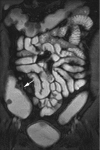Recent advances in intestinal imaging
- PMID: 22013290
- PMCID: PMC3190487
- DOI: 10.4103/0971-3026.85363
Recent advances in intestinal imaging
Abstract
In recent years, advances in scanner technology and competition from other specialties have produced rapid changes in the way the intestines are imaged. MRI and CT scan along with the traditional enteroclysis examination have emerged at the forefront of intestinal imaging. Functional modalities such as diffusion and perfusion imaging are also changing the way tumors and inflammatory bowel diseases are evaluated. CT colonography is now a valid alterative to optical colonoscopy. Contrast-enhanced USG is being used for the assessment of inflammation and post-treatment changes. In this review, recent advances in intestinal imaging are described.
Keywords: Computed tomography; intestines; magnetic resonance imaging.
Conflict of interest statement
Figures








Similar articles
-
New progress in CT and MRI examination and diagnosis of small intestinal tumors.World J Gastrointest Oncol. 2010 May 15;2(5):222-8. doi: 10.4251/wjgo.v2.i5.222. World J Gastrointest Oncol. 2010. PMID: 21160621 Free PMC article.
-
Modern imaging using computer tomography and magnetic resonance imaging for inflammatory bowel disease (IBD) AU1.Inflamm Bowel Dis. 2004 Jan;10(1):45-54. doi: 10.1097/00054725-200401000-00008. Inflamm Bowel Dis. 2004. PMID: 15058527 Review.
-
Comparison of magnetic resonance imaging colonography with conventional colonoscopy for the assessment of intestinal inflammation in patients with inflammatory bowel disease: a feasibility study.Gut. 2005 Feb;54(2):250-6. doi: 10.1136/gut.2003.037390. Gut. 2005. PMID: 15647190 Free PMC article.
-
Computed tomography enteroclysis in the diagnosis of intestinal diseases.J Comput Assist Tomogr. 2008 Jan-Feb;32(1):9-16. doi: 10.1097/rct.0b013e318059bed7. J Comput Assist Tomogr. 2008. PMID: 18303282 Review.
-
IVIM with fractional perfusion as a novel biomarker for detecting and grading intestinal fibrosis in Crohn's disease.Eur Radiol. 2019 Jun;29(6):3069-3078. doi: 10.1007/s00330-018-5848-6. Epub 2018 Dec 13. Eur Radiol. 2019. PMID: 30547200
Cited by
-
MRI enterography with divided dose oral preparation: Effect on bowel distension and diagnostic quality.Indian J Radiol Imaging. 2013 Jan;23(1):86-91. doi: 10.4103/0971-3026.113623. Indian J Radiol Imaging. 2013. PMID: 23986622 Free PMC article.
-
Exploring the neglected segment of the intestine: the duodenum and its pathologies.Pol J Radiol. 2020 May 8;85:e230-e244. doi: 10.5114/pjr.2020.95477. eCollection 2020. Pol J Radiol. 2020. PMID: 32612721 Free PMC article. Review.
-
In Vivo Dynamic Coronary Arteries Blood Flow Imaging Based on Multi-Cycle Phase Clustering Ultrafast Ultrasound.Adv Sci (Weinh). 2025 Aug;12(31):e05485. doi: 10.1002/advs.202505485. Epub 2025 Jun 30. Adv Sci (Weinh). 2025. PMID: 40588810 Free PMC article.
-
Clinical characterization of in vivo inflammatory bowel disease with Raman spectroscopy.Biomed Opt Express. 2017 Jan 4;8(2):524-535. doi: 10.1364/BOE.8.000524. eCollection 2017 Feb 1. Biomed Opt Express. 2017. PMID: 28270965 Free PMC article.
-
Advancing peristalsis deciphering in mouse small intestine by multi-parameter tracking.Commun Biol. 2023 Dec 7;6(1):1237. doi: 10.1038/s42003-023-05631-2. Commun Biol. 2023. PMID: 38062160 Free PMC article.
References
-
- Balthazar EJ, Herlinger H, Maglinte D, Birnbaum BA. 2nd ed. Germany: Springer; 2001. Clinical Imaging of the Small Intestine.
-
- Maglinte DD, Kelvin FM, O’Connor K, Lappas JC, Chernish SM. Current status of small bowel radiography. Abdom Imaging. 1996;21:247–57. - PubMed
-
- Maglinte DDT. Small bowel imaging: A rapidly changing field and a challenge to radiology. Eur Radiol. 2006;16:967–71. - PubMed
-
- Maglinte D, Sandrasegaran K, Chiorean M, Dewitt J, McHenry L, Lappas J. Radiologic investigations complement and add diagnostic information to capsule endoscopy of small-bowel diseases. AJR Am J Roentgenol. 2007;189:306–12. - PubMed
LinkOut - more resources
Full Text Sources

